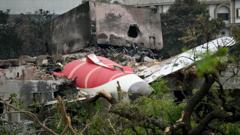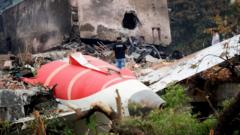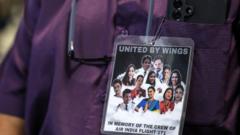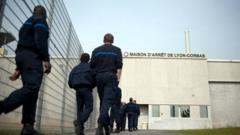Investigators uncover unsettling details from the cockpit voice recorder of Air India Flight 171, revealing mysterious actions by the pilots leading to the crash that killed 260 people. With conflicting accounts and questions surrounding the operation of fuel-control switches, the inquiry seeks clarity amid complex aviation protocols.
Cockpit Audio Reveals Unfolding Mystery in Air India Flight 171 Crash
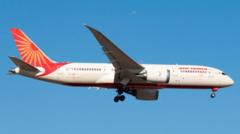
Cockpit Audio Reveals Unfolding Mystery in Air India Flight 171 Crash
The dark enigma of Air India Flight 171's fatal crash grows deeper as cockpit recordings suggest unexplained actions by the pilots just seconds after takeoff, raising vital questions on safety features and pilot decisions.
Investigators are grappling with perplexing revelations from the preliminary inquiry into the Air India Flight 171 crash, which tragically claimed 260 lives in June. Shortly after takeoff, critical fuel-control switches on the Boeing 787 Dreamliner, only 12 years old, were moved to the "cut-off" position, halting fuel supply to the engines and precipitating a total power failure. This operation is atypical, as it is generally performed only once a flight has landed.
The cockpit voice recordings reveal a tense exchange, with one pilot questioning the other about why he had "done the cut-off," to which he replied he hadn't. The anonymity of the speakers adds to the confusion during a time when the co-pilot was piloting the aircraft and the captain was monitoring operations.
As the airplane climbed to 625 feet, it had only been airborne for 40 seconds before crashing in a densely populated area of Ahmedabad. Investigators have been examining the wreckage and cockpit recorders to unravel the events leading to this perplexing disaster. An initial 15-page report suggests troubling inconsistencies regarding the fuel-control switches, which are designed to prevent accidental activation through a locking mechanism—making their unexpected positioning both unusual and alarming.
Experts involved in the investigation, including representatives from Boeing and the US and UK aviation authorities, are left with numerous questions. The switch design was established decades ago, and experts have noted that a pilot’s accidental touch of both switches simultaneously would be nearly impossible, raising the question of whether the switches were deliberately operated, and if so, why.
Former accident investigator Shawn Pruchnicki reflects on the need to determine whether the actions were intentional or stemmed from misunderstanding instructions in a crisis; the absence of reported anomalies prior to the takeoff belies the likelihood of such errors. Peter Goelz, a former NTSB director, echoed concerns about the hasty nature of the situation, underscoring that more context would likely be found in the cockpit voice recorder.
Further analyses suggest a critical need for identifying speaker voices within the recordings. With unlabelled speakers, clarity regarding the pilot's actions remains elusive and further scrutiny of all communications is required, including recommendations for cockpit video recorders to enhance oversight.
Compounding the mystery, the report points out a warning issued by the US Federal Aviation Administration (FAA) about the disengagement of locking features in a similar series of control switches, raising questions about whether similar vulnerabilities existed in the Boeing 787-8 model involved in the crash. Despite concerns about contamination of fuel leading to twin engine failures, mechanical issues have not yet been substantiated.
Additionally, the aircraft's Ram Air Turbine (RAT) deploying indicates significant failures, as both engines lost power. Analysis of the landing gear’s failure to retract added another layer of complication, suggesting that pilot reaction under the impending crisis diverted focus towards maintaining a controlled descent rather than retraction protocols.
Ultimately, the sequence of events unfolded rapidly, illustrated by the pilots' attempts to relight the engines. Investigators recognized that both engines were not able to regain sufficient thrust in time, leading to the tragic crash that awaited them just moments after takeoff. The intentions and decisions of the cockpit crew remain under scrutiny as the investigation unfolds, with many chapters still unwritten in this somber aviation saga.






